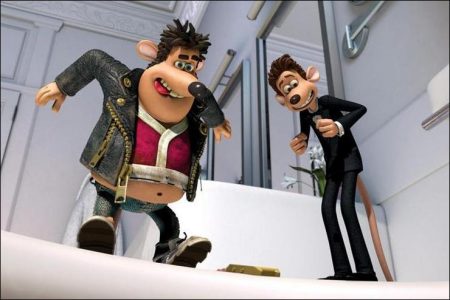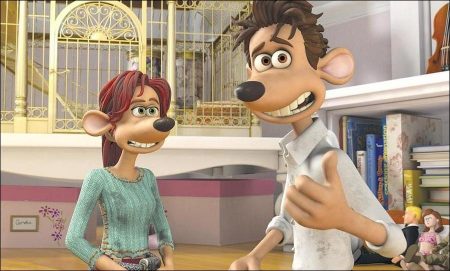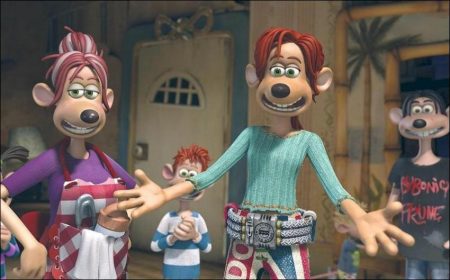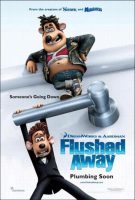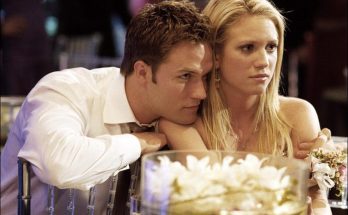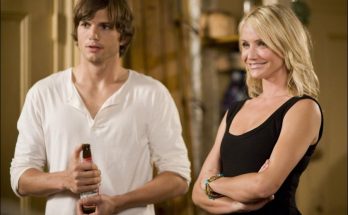Tagline: Someone’s going down.
From DreamWorks Animation and Aardman Features, the teams behind the Oscar-winning hits “Shrek” and “Wallace & Gromit: The Curse of the Were-Rabbit,” comes the computer-animated comedy “Flushed Away.” Blending Aardman’s trademark style and characterizations with DreamWorks’ state-of-the-art computer animation, the film marks a unique new look for the artform.
In this new comedy set on and beneath the streets of London, Roddy St. James (Hugh Jackman) is a pampered pet mouse who thinks he’s got it made. But when a sewer rat named Sid (Shane Richie) – the definition of “low life” — comes spewing out of the sink and decides it’s his turn to enjoy the lap of luxury, Roddy schemes to rid himself of the pest by luring him into the loo for a dip in the “whirlpool.” Roddy’s plan backfires when he inadvertently winds up being the one flushed away into the bustling world down below.
Underground, Roddy discovers a vast metropolis, where he meets Rita (Kate Winslet), a street-wise rat who is on a mission of her own. If Roddy is going to get home, he and Rita will need to escape the clutches of the villainous Toad (Sir Ian McKellen), who royally despises all rodents and has dispatched two hapless henchrats, Spike (Andy Serkis) and Whitey (Bill Nighy), as well as his cousin — that dreaded mercenary, Le Frog (Jean Reno) – to see that Roddy and Rita are iced… literally.
Plumbing Together
After achieving success with the critically acclaimed box-office hit “Chicken Run” and the Academy Award-winning “Wallace & Gromit: The Curse of the Were-Rabbit,” DreamWorks Animation and Aardman Features team up for the third time with “Flushed Away.” For this film, the two studios took their collaboration to a new level: after being conceived at Aardman’s UK studio, “Flushed Away” became the company’s first computer-animated film and was produced entirely at DreamWorks’ animation studio in Glendale, California.
According to director David Bowers, the movie reflects the best of what each studio has to offer. “We have Aardman’s charm and rich sensibilities, and all the imagination and technological capabilities of DreamWorks,” Bowers attests. “I don’t think the movie could have happened without either studio.”
As “Flushed Away” was in its early stages of development, the filmmakers realized their third collaboration would need to be entirely computer-animated for several reasons. Water is notoriously difficult to recreate in stop-motion, and the sets would have to be enormous to be in proportion with Roddy, Rita, and the rest of the “Flushed Away” characters.
According to director Sam Fell, Aardman had been looking to make a CG animated film for some time, and “Flushed Away” seemed to be the right project to make the jump.“We wanted to create a whole city, a whole world, and populate it with thousands of little rats walking around along canals instead of streets,” says Fell. “With water, crowds, big scope, many sets – it seemed like CGI could really help us make that happen.”
Bowers agrees. “The Kensington apartment, where the movie begins,would have had to have been full size,” he says. “There just wouldn’t have been room in the studio to do it. And there wouldn’t have been enough plasticine or clay in the world to do it.”
“At first, we thought we would do a stop-frame film with a lot of CG enhancements,” says Aardman co-founder and producer David Sproxton. “But when we looked at how much we would be doing on the computer – the extensive tunnels, the large sets, the water – we thought,‘Why not make the whole thing in CG?’”
In addition to the scaling challenges, the myriad water effects – critical components to a story set largely within a sewer world – provided an even more convincing case for CG. From Roddy’s titular tumble into the toilet’s whirlpool to the frenetic boat chase leading up to the film’s climax, water would need to be as versatile as the characters themselves.
Aardman co-founder and producer Peter Lord explains,“Water is practically a character in this film, and it’s just the hardest thing to do in stop-frame animation,” he says. “When we do water, it’s normally little bits of cling film making a splash, or animating drips of glycerin trickling down the damp character. To have a boat bobbing about on a stream or tearing along at a super speed, through a river, chased by villains on egg whisks – it would have been impossible.”
Head of effects Yancy Lindquist comments, “We have flushing water. We have water running down pipes. We have frozen masses of water. Each of those requires a slightly different technique.”
Like the directors, Lord says that “Flushed Away” remains a film that could only have been made by a collaboration between Aardman and DreamWorks. “I think ‘Flushed Away’ brings a stillness to the CG art form,” Lord says. “We believe in performance above all; the audience needs to believe in the characters. That often means watching what happens on the face when the character is almost still. That subtlety is what we do best. On the other hand, computer animation is great for big action. By putting the two together, we’ve got strong, believable characters and some truly spectacular action sequences.”
Visual effects supervisor Wendy Rogers expands on the idea of stillness: “We really have treated the characters as though they were puppets, and they’re animated to move that way,” she says. “We don’t have any dynamic simulation on the hair. Their clothing doesn’t flow when they walk. They’re hitting that pose and holding it rather than sort of easing through a motion.” While the film is set primarily in a fanciful underground world, the real life lessons are unmistakable.
Thrust together in their efforts – first to escape The Toad, then to put a stop to his dastardly plan – Roddy and Rita learn to rely on each other. “More than anything else, Rita wants to help her family,” producer Cecil Kramer says. “But she needs to learn that she can’t do that alone. When she opens herself up to accepting Roddy’s help, anything is possible. And Roddy’s journey is universal. You can have all the toys in the world, but they’re not worth much if you have no one to share them with. At the end of the day, we all need friends and families to connect, even the finest possessions pale in comparison to our relationships with others.”
Dual Diligence
From the characters themselves to the sets and backgrounds, Aardman films have a distinct look and feel – a style the filmmakers wanted to continue in “Flushed Away.” Because stop-motion technique itself is so integral to that style, bringing the Aardman look to CG required unique character design, careful attention to detail, and ultimately, a little restraint. The filmmakers knew they wanted to retain the patent Aardman characterizations in CG, but they were also determined to avoid direct replication of the clay figures into computer models. In combining the advantages of computer animation with the corporeal quality of stop-motion, they created something new – an evolution of the Aardman style.
“There’s definitely a look to the design of an Aardman stop-motion film,” asserts Sproxton. “There’s a texture that’s inherent in model work – the fingerprints on the clay, the wood grain, the plaster, the paint. You get a lot of texture simply because the sets and characters are constructed from real materials. That look is distinctly Aardman. I would say it’s our trademark.”
“We worked hard to translate the stop-frame style into the computer animated technique,” Fell states. “We wanted to use the CG technique to capture the signature Aardman warmth, charm, and tactile feel. It’s the best of both worlds, really.”
In a stop-motion film, Aardman artists create plasticine models with metal armatures. Stop-motion animators pose the characters’ bodies and sculpt their faces frame by frame. As a result of this painstaking process, the characters hit poses very quickly and communicate largely through facial expressions.
As Jeff Newitt, head of character animation, explains, the creators of “Flushed Away” found themselves freed by the new boundaries of CG, but constantly kept in mind the goal of matching the Aardman style. “The stopmotion armatures are restricted by gravity, and the weight of the clay or rubber or foam used in building the puppets,” Newitt says. “So when you animate them, you’re actually trying to achieve a kind of innovation through limitation most of the time, and a natural style has evolved. Since you don’t have those impediments in CG, animators actually have to use a lot of restraint to preserve it.”
Melding the two animation styles was a trial-and-error exercise in the character rigging stage of production. During this phase, fully modeled and rigged characters are created in the computer based on the art department’s designs and specifications, as well as the needs of the animation team.
Some of the benefits of working in CG were immediately apparent. “Consider The Toad,” offers Newitt. “You have a massive bell-shaped body with very spindly legs. There’s so much weight to support and almost nothing to carry it. A character like that is an absolute nightmare to produce in stop-motion, but in CG, you don’t have to worry about gravity.”
Of course, there were also challenges during this translation process. “When we started doing the rigs, they matched the Aardman puppets almost exactly,” says lead character technical director Martin Costello. “But we found that some of the movements really didn’t work well in computer animation. So they evolved into something new, though there are still many similarities with traditional Aardman puppets, particularly the mouths and the brows.”
In traditional stop-motion, animators use a variety of mouth pieces for each character. These pieces are removed and replaced with different shapes in nearly every frame which allow the animators to not only make their characters speak but also create different expressions. To recreate this look in CG, the rigging department generated those replacement shapes within the computer. “In stop-motion, they physically remove one mouth shape and put in another in nearly every frame,” Costello notes. “So we made sure we could do the same thing on the computer.”
One of the most difficult components of the CG facial rig was the trademark Aardman monobrow. On a clay figure, the monobrow is a piece of plasticine that hangs above the eyes, small plastic spheres which are pushed into the brows to form sockets.The brow is then raised slightly to form two furrows above the eyeballs. Costello cites Gromit – the silent canine partner of Aardman’s Wallace and Gromit franchise – as the best example of the brow’s importance. “Gromit doesn’t speak; he basically does all his acting with his brow. It’s very subtle and it’s a real mark of Aardman animation. So we had to mimic that in ‘Flushed Away.’”
It took months to develop a CG rig that captured the right level of expressiveness. The monobrow rig had to reflect the clay-like feel of the character’s brow. Controls were added to the eye sockets to form a ridge, a sort of “false-brow” upon which the protruding brow would rest. Other controls were added to flatten and fatten the brow. Frown lines were added as scalable displacement maps to imitate the scoring of clay by modelling tools.
“Aardman animators move the characters’ faces by hand,” Costello says. “Their fingers can make the smallest changes to reflect a character’s emotions or thoughts. The computer controls had to give our animators that same ability, because obviously we can’t just give the computer a giant thumb.”
Thumb or no thumb, the Aardman thumbprints are all over the characters of Flushed Away – literally and figuratively. When Spike receives an electric shock, the skeleton that shows through is actually a stop-frame armature. And if you look closely enough, Bowers shares,“you’ll see in some rare spots, some of the characters even have a few thumbprints on them.”
The Wet Look
While water is considerably more problematic in stop-motion, it’s not exactly easy in CG. Lighting artistic supervisor Mark Edwards notes,“Water is particularly difficult because, obviously, people already know what it looks like. They know how it moves and behaves, and they’re going to be watching with a critical eye. So we needed to capture just enough realism in the water’s appearance and movement without disrupting the movie’s visual style.”
To design the varying water patterns, the effects team combined technology with basics: fluid-simulating software inspired by the real physical properties of water.These physical experiments are used as references, and then it’s up to the effects team to translate the real-life visuals into CG.
“There’s a scene right after Roddy is jettisoned out of a pipe and up against a sewer grate and is doused with water,” Lindquist recalls. “We weren’t sure exactly how that should look, how the water would appear on impact, how it would drip off Roddy’s body. So we got some buckets, some hoses, some volunteers, and went outside.”
The reference for the toilet flush scene was a little more challenging to obtain. “Toilets that aren’t low-flow are practically nonexistent in Los Angeles,” Kramer explains. “We went outside the country to find the right flush. The whirlpool that sucks Roddy underground was actually inspired by footage of a toilet in a British pub, courtesy of one of our Bristol colleagues.”
Lindquist adds, “The flush scene is actually a sequence of three shots, using two different techniques to achieve the look. The first two shots were created by taking a flat surface and deforming it into a shape that closely resembled the flushing water from the pub footage, and the third is where the water actually goes down. This is all done with the fluid simulator. We input the speed of the water, and the desired movement, and we just let the simulator run. At that point, it’s just tweaking and fine tuning.”
Lighting the flush sequence presented its own unique challenges. Similar to illuminating sets in live-action films or theater stages, CG lighting is essential to shaping the forms on the screen and in establishing depth of field – attracting the audience’s focus to the desired character or action so that they are not distracted by all of the tertiary details within the frame.
Edwards offers, “I don’t think anyone has ever attempted an actual flushing toilet with swirling water, so we weren’t working off of any precedents. It was challenging, trying to get the proper caustics and balance the reflections, but I really like the way the scene turned out. It’s really wild, and certainly one of the key moments in the film.”
Slugging Out The Score
When it comes to setting the mood of a film, there’s no substitute for a well-conceived score and some well-chosen songs. From the fast-paced chase sequences to the tender moments in Roddy and Rita’s budding relationship to the slugs’ frequent comedic appearances, music provides an indispensable aural backdrop for “Flushed Away.”
“We wanted a classic score, one that would really strike the balance between comedy and adventure, which is really what this film is,” explains Fell. “In some ways, it’s like an ‘Indiana Jones’-type movie, with fabulous action sequences, but in other places, it’s really quite silly and comic. We were looking for something that recalled the old cartoon scores like Carl Stalling’s arrangements with Tex Avery.”
To bring this score to fruition, the directors turned to Harry Gregson-Williams. “We were very lucky to have Harry,” Bowers states. “He did the ‘Shrek’ films, and ‘Narnia,’ and he’s produced this sort of sweeping London-esque, fantastically uplifting score that we just love.”
Having composed the score for several DreamWorks Animation films, Gregson-Williams embraced the process of composing for “Flushed Away.” He states, “It’s a particularly collaborative experience, scoring an animated movie. It’s quite a substantial commitment, compared with live action. It’s never really finished until it’s finished. Cues change, scenes expand. I’ll start developing the music when the film is in the storyboard stage, then adjust it as I go along.”
When he first started composing the “Flushed Away” score, Gregson-Williams focused at first not on the beginning of the film or any of the fast-paced action sequences, but a poignant moment in the middle of the movie. “There’s a scene in the middle of the film where Roddy and Rita are having dinner, and she’s asking him to tell her about himself,” he says.
“And Roddy claims to have a wonderful life, surrounded by friends and relatives. But it’s not true, and he’s beginning to realize that he’s actually sad about that. It’s a subtly emotional scene, and a momentary break from the frenzied pace of the film. It might sound a bit odd that I would start in the middle, but I saw it as the point where it all ties together. Having started there, I then doubled back to the beginning of the movie and thematically built towards that crucial scene.”
The song selection was equally deliberate, and ultimately parallels the somewhat haphazard quality of the sewer world. “We have a fairly eclectic selection of songs and artists,” Bowers notes. “We wanted it to be fun, but we also wanted to capture a wide variety of different feelings, because it’s a city, complete with that urban city feel. So we have several artists, including the Jets, the Dandy Warhols, even Tina Turner.”
But the filmmakers didn’t limit themselves to established musicians;“Flushed Away” also marks the musical debut of the scene-stealing slugs. These slippery singers started off as extras, just another kind of unfamiliar creature for Roddy to encounter with trepidation. But Fell and Bowers soon realized that the slugs had some serious comic potential.
“We started off with just a few slugs that let out these hilarious high-pitched screams when Roddy first meets them,” Fell recalls. “But they were so funny and cute, we started to look for other spots in the film for them to show up.”
Since the slugs had become a crew favorite, the bid to increase their screen time was well-received. “Before long,” notes Kramer, “we were thinking, ‘Wouldn’t it be great to have them singing?’ So they became something of a comic Greek chorus, which contributed to the kind of silly, whimsical, humorous style of our movie.”
While the slugs do provide the background vocals for a scene where Roddy serenades Rita from the underground river, Bowers admits that there was some lip-synching involved in the finale, a spirited rendition of “Proud Mary.” “We really wanted to hear Tina Turner’s voice coming out of those slugs. We just thought it would be very funny. And it is.”
Flushed Away (2006)
Directed: Sam Fell, David Bowers
Starring: Hugh Jackman, Kate Winslet, Ian McKellen, Andy Serkis, Bill Nighy, Shane Richie, Geoffrey Palmer, Jean Reno, Kathy Burke, Susan Duerden Miriam Margolyes
Screenplay by: Dick Clement
Production Design by: David James
Film Editing by: Erika Dapkewicz, John Venzon
Costume Design by: Jane Poole
Art Direction by: Pierre-Olivier Vincent, Scott Wills
Music by: Harry Gregson-Williams
Cinematography by: Brad Blackbourn, Frank Passingham
MPAA Rating: PG for crude humor and some language.
Studio: DreamWorks Pictures
Release Date: November 3, 2006
Visits: 143
